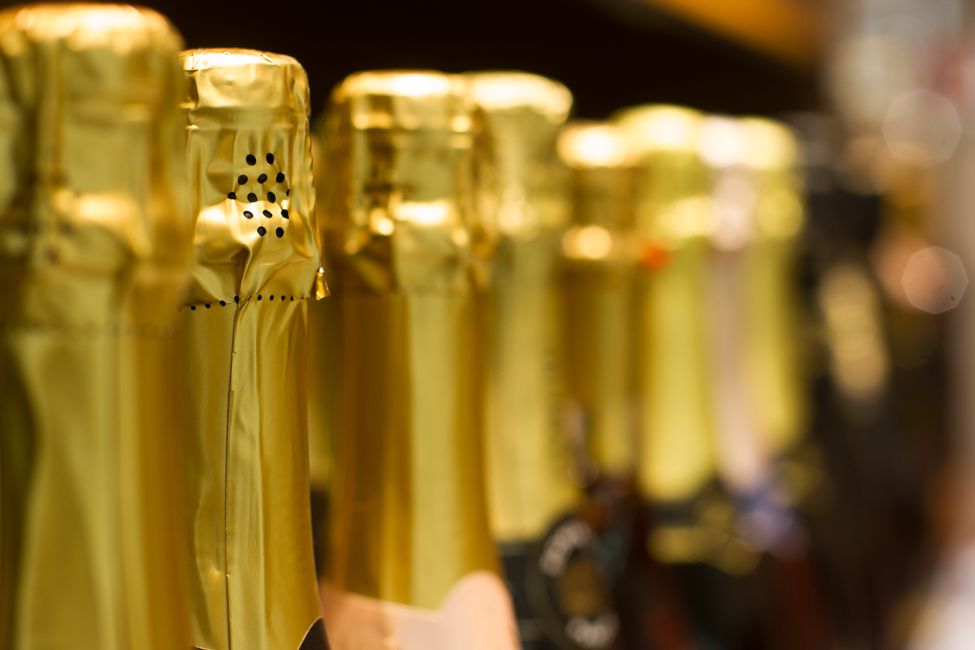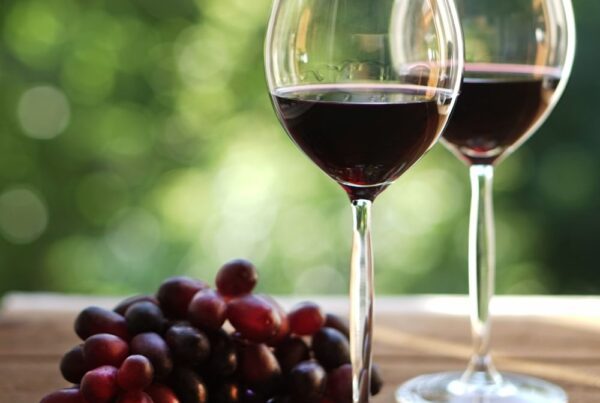The labelling on bottles of wines is often complicated and confusing. Countries label things differently and in a variety of languages.
Some terms listed on wines are legal terms with specific meanings, but others are not legal and their meaning can therefore be ambiguous.
In this article, you will learn the what the terms Cuvée and brut mean.
Cuvée and brut are both terms that are often used on Champagne and sparkling wine labels and mean very different things.
Key takeaways:
- Cuvée has different meanings that relate to a type of blend, usually a Champagne blend. It can mean:
- a special blend or batch of wine
- a blend of different grape varieties to make a wine
- the juice from the first pressing of Champagne grapes
- The word “brut” means dry and a Brut label generally refers to a dry style of Champagne or sparkling wine.
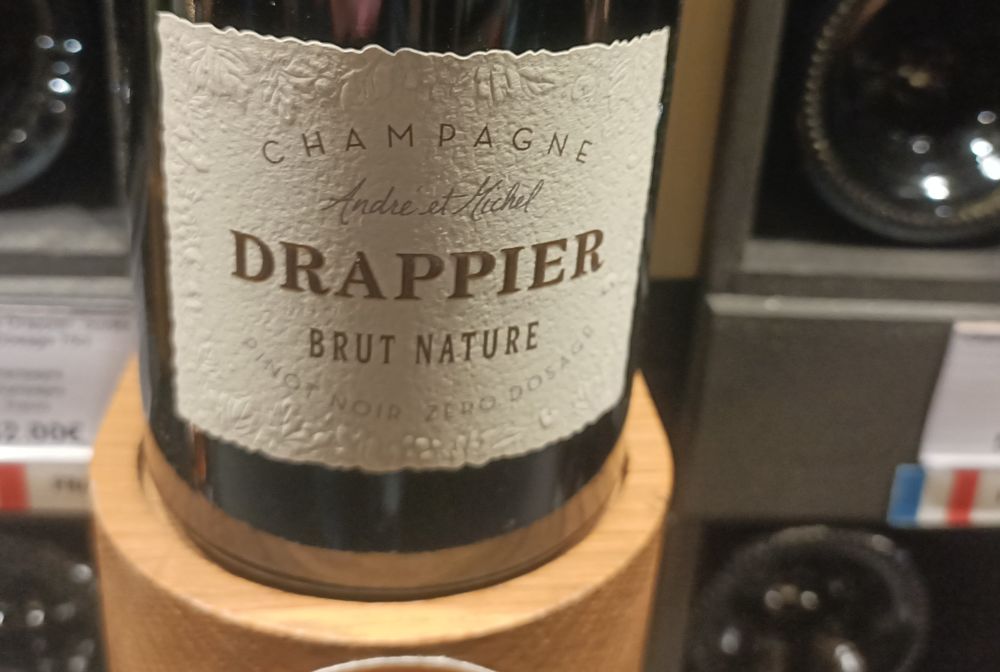
Contents
What the term cuvée means
The term cuvée has many different meanings, but it most commonly refers to a blend, especially for Champagne.
There are two types of blends that it can refer to:
- a specific or special blend of wine by a winemaker.
- a blend meaning wine made from a variety of different types of grapes.
The word cuvée is derived from the word “cuve” which means tank.
The World Atlas of Wine (Sixth Edition) defines cuvée as a French term for a blend, especially the final blend in sparkling winemaking.
The term cuvée is usually used by winemakers to identify their higher quality wines. It can indicate a special blend or higher quality blend by a wine producer.
Cuvée can also mean the first pressing of Champagne grapes that contains the purest juice.
The subsequent pressings and juice are known as the taille.
The best Champagne is made using only cuvée (first press juice).
Prestige cuvée meaning
This is a term that describes the best wine or Champagne that a wine producer has to offer. It is used especially to describe Champagne.
Cuvée Prestige wines are premium offerings are often considered the pinnacle of a winemaker’s skill and artistry.
Winemakers identify specific vineyards or even individual sections within vineyards with the highest quality grapes. These vineyards often have ideal soil compositions, microclimates, and vine age.
In most cases, grapes for Cuvée Prestige wines are hand-harvested. This reduces the risk of damage and preserves the condition of the grapes.
Grapes for Cuvée Prestige wines undergo meticulous sorting. The grapes are carefully inspected to ensure that only flawless, perfectly ripe grapes are chosen.
Cuvée Prestige wines often embrace traditional winemaking techniques, including spontaneous fermentation with indigenous yeasts and aging in oak barrels.
These wines also typically undergo extended aging in the winery’s cellars. The length of aging can range from several years to over a decade. This extended maturation allows the wine to develop intricate flavors, aromas and a silky texture.
Some Cuvée Prestige wines are blends of different grape varieties or vintages. Winemakers carefully select and blend to create a harmonious and balanced final product.
Wineries often allocate only a small portion of their grapes for Cuvée Prestige wines, ensuring exclusivity and rarity.
Cuvée Prestige wines have excellent aging potential. Many collectors and enthusiasts purchase them with the intention of cellaring them for several years or even decades to experience them at their peak.

Tête de Cuvée meaning
Tête de Cuvée is a labelling term that is usually associated with Sauternes AOC.
It is an indication of higher quality.
What the term brut means
Brut, in the context of sparkling wine, means dry.
Champagne has various terms on the labels of bottles that are indications of sweetness (see infographic below).
A Brut Champagne means it contains between 0-12 grams of sugar per liter.
It is a dry or off-dry Champagne.
Note: Even the driest sparkling wine, Brut Nature can contain some sugar (0-3 g/L). It will taste dry, however, because the sugar is balanced out by the acidity in the wine.
Is Brut Champagne sweet?
Brut Champagne is generally considered a dry style of Champagne.
That said, it can have up to 12 grams of sugar per liter, so it won’t necessarily be a bone-dry wine.
The sweetness is balanced out by the acidity in the wine, meaning it can taste dry in the mouth; however, depending on the exact sugar levels, it may have a slight sweetness to it.
Brut vs extra dry meaning

Brut and extra dry are both terms that reference the sweetness levels in Champagne or sparkling wine.
Merriam Webster dictionary defines brut as ‘extra dry’; however, as outlined above, in Champagne terms it simply means dry on the Champagne dryness scale (see sweetness levels in sparkling wine infographic below).
It sounds counterintuitive, but Brut Champagne contains less sugar than Extra Dry Champagne.
Brut Champagne has 0-12 g/l and Extra Dry Champagne contains between 12-17 g/l.
You shouldn’t have to formally study wine, as I have, or carry a calculator to work out how sweet Champagne is, but there we are!
Champagne sweetness levels from dry to sweet
There are seven different sweetness levels for Champagne and sparkling wines.
The levels are distinguished by grams of sugar per liter (g/l).
Each level has a range within it, so one Brut Champagne, for example, could be sweeter than another because it is at the higher end of the range.
The names of the terms used to describe different sweetness levels are also somewhat confusing and counterintuitive.
A consumer buying a Champagne labelled as “Extra Dry”, for example, could reasonably assume that they are buying a dry Champagne.
Unfortunately, this is not really the case because Extra Dry Champagne contains at least 12 grams of sugar per liter and as much as 17 grams of sugar per liter.
The EU has labelling terms to denote sweetness levels that must be used for sparkling wines.
Many of these labelling terms are similar around the world. So, they are a good indication of sweetness levels, but the labelling terminology may differ depending on where you live.
The Champagne dryness scale, according to the EU labelling terms for sweetness levels in sparkling wine, is as follows from driest to sweetest:
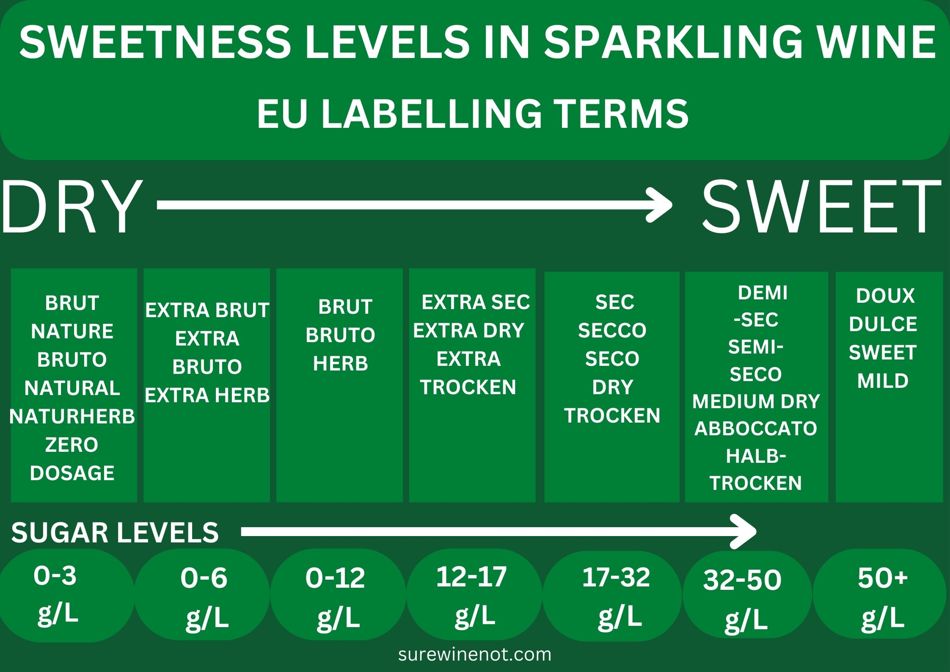
Brut Nature: 0-3 g/l
Brut Nature has the least amount of sugar of any type of Champagne.
If you like your Champagne or sparkling wine bone dry, then this is the sweetness level for you.
It can have very small amounts of sugar, but it will not taste sweet because any sweetness is balanced out by the acidity in the wine.
Extra Brut: 0-6 g/l
Extra Brut contains up to 6 grams of sugar per liter, so up to double what is permitted for Brut Nature.
That said, it is still considered a dry wine. Small amounts of sugar can create a more balanced wine. Extra Brut will usually not taste sweet at all.
If you like dry wine but not bone-dry wine, Extra Brut is an excellent option.
Brut: 0-12 g/l
Brut is not too sweet or too dry, which is probably why it is one of the most popular styles of Champagne or sparkling wine.
With sugar levels up to 12 grams per liter, it can have a hint of sweetness.
Extra Dry: 12-17 g/l
Despite its name, Extra Dry is not really that dry as it contains up to 17 grams of sugar per liter.
If you like off-dry wines or medium-dry wine, then this could be the right level for you.
Dry: 17-32 g/l
Again, despite its name, this is not really a dry wine.
It tastes more like a semi-sweet wine with up to 32 grams of sugar per liter.
Medium Dry: 32-50 g/l
Medim Dry is another step up in sweetness from the previous level. It is another semi-sweet wine.
If you like sweet wine, but you find dessert wines too syrupy, this could be the right style for you.
Sweet: 50+ g/l
Sweet or Doux Champagne is the sweetest level available.
It is another step up in sweetness from the Medium Dry level.
Different types of Champagne
The labelling on Champagne bottles usually contains more than just a reference to the sweetness levels. Labels will also usually have a reference to the type of Champagne.
Blanc de Blanc Champagne
Blanc de Blanc means “white from white” and is Champagne that is made using only white grape varieties.
Champagne is typically made using a blend of Chardonnay, Pinot Noir and Meunier.
Blanc de Blanc is often made with 100% Chardonnay, like the one pictured below.
Blanc de Noir Champagne
Blanc de Noir means “white from black” and it is Champagne made using only black grape varieties.
It is typically made using Pinot Noir or Meunier or a blend of both.

Rosé Champagne
Rosé Champagne ranges from pale pink to salmon and even orange in color.
It is made in two different ways – direct pressing and maceration.
A third method for making rosé, where a small amount of red wine is added to a white wine to produce a rosé wine is not permitted in Champagne.
Direct pressing
Black grapes are crushed and pressed extracting a small amount of color from the tannins in the grape skins. Using this method can produce delicate pale pink rosés wines.
Short maceration
Black grapes are crushed and then left to macerate for a period of time. This extracts both color and flavor. The juice is then drained off the skin and fermented into wine.
Vintage Champagne
Vintage Champagne is made using grapes from a single year’s harvest. It must then be aged for a minimum of three years before being released for sale.
Vintage Champagne is made using the same grape varieties as those used for non-vintage Champagne.
The weather in a specific vintage year, combined with the choice of grape varieties, blending decisions and other winemaking techniques ensure that each vintage is entirely unique.
Non-Vintage Champagne
Non-vintage Champagne is made by blending wines from different years.
Having a choice of wines from different years gives winemakers more choice for blending wines. It ensures that Champagne makers can create a consistent style of wine each year or a specific house style.
FAQ
How do you pronounce cuvée?
Pronounce cuvée: KOO-VAY.
Is brut Champagne sweet?
Brut Champagne has between 0-12 g/L. It is generally considered a dry Champagne.
Is brut better than blanc de blanc?
Brut, as discussed above, is a term that refers to sweetness levels in Champagne or sparkling wine.
A brut Champagne is, generally speaking, a dry Champagne.
Blanc de blanc is a term that refers to the type of grapes used to make Champagne. Blanc de blanc Champagne is Champagne made with white grapes only, usually Chardonnay grapes.
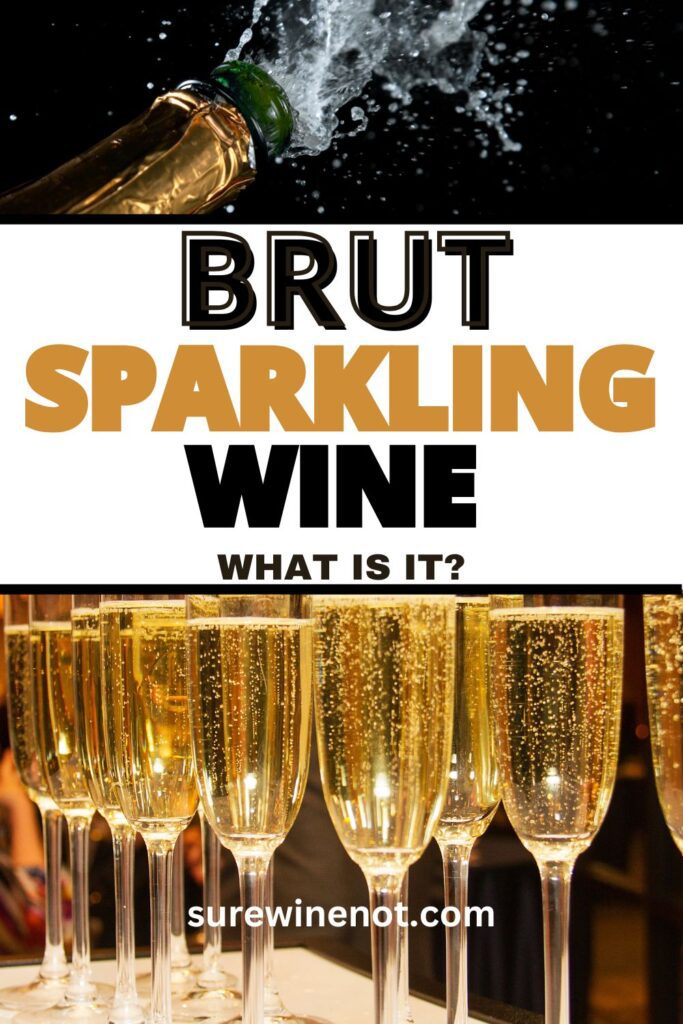
Read with confidence: I am a certified wine expert (WSET L3).


